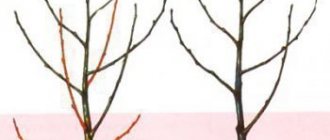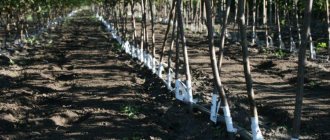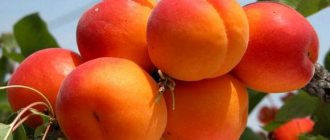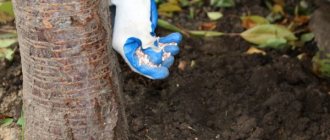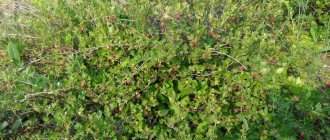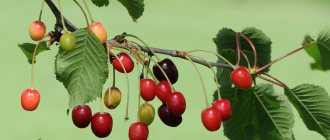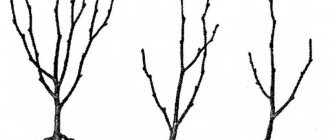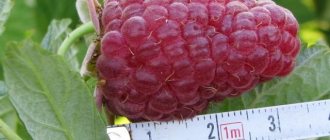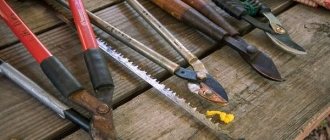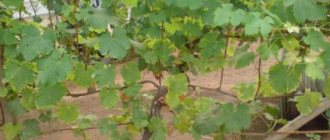Benefits of autumn planting
Typically, cherries are grown in the south of Russia, since they are very sensitive to low temperatures. But thanks to successful breeding work, varieties have appeared that are resistant to frost and begin to ripen early. Growing such cherries will be successful in more northern regions.
In the south of the country, it is preferable to plant this crop in the fall, when the trees shed their leaves. When planting in the spring months, there is a high probability of damage to the fragile tree due to extreme heat already at the end of March or April, insect infestation and dry winds. If planted in autumn, the tree takes root and has time to grow stronger before spring. In the southern part of the country there are no significant frosts in winter.
In Siberia, Central Russia and the Far East, cherries are planted in the spring. Then over the summer the plant manages to get stronger and take root. When planting in spring, the tree is constantly inspected - irrigated on time, protected from harmful insects and diseases.
Important! To preserve plants purchased in the fall before planting, they are buried in the ground at an acute angle in a trench 60 cm deep, with the upper parts directed towards the south. If several copies were purchased, they are buried together, having previously been tied.
To protect against winter frost, seedlings are sprinkled with soil and snow on top. To avoid damage from bright sun, sheets of plywood are placed on top.
The best varieties for a personal plot
When choosing seedlings, you need to pay attention to its zoning, since southern varieties will freeze or dry out in colder climates with high snow cover.
Do you already have beautiful, tasty cherries growing in your garden?
YesNo, not yet
Therefore, before going to the nursery, you should pay attention to some points:
- Frost resistance . The higher it is, the better.
- Short stature . Such plants are less likely to freeze and have higher yields.
- Late flowering period . It allows you to escape from the returning cold.
- Self-fertility . Such varieties do not require cross-pollination, therefore, harvesting is guaranteed even when planting one plant.
Taking into account all factors, you can decide on the variety.
And the way
A tree of medium height (4-5 m) of pyramidal shape with a dense crown. Thick, shortened petioles with three to four white flowers. Flowering early. Fruits of universal use up to 9 g (considered large) are glossy, burgundy to black in color. Juicy, sweet pulp.
Self-sterile, productive (up to 30 kg) variety, resistant to fungal infections.
Lapins
A variety of Canadian selection with low frost resistance, productive with simultaneous ripening of fruits that do not fall off for a long time.
The fruits are large – up to 8 g, transportable. With enhanced agricultural technology, they reach 13 g. Orange-red color and dense pulp. A variety with great vigor, highly productive, self-fertile, late-ripening. Fruiting begins at the end of July. Universal berries.
Leningradskaya black
The height of the tree usually does not exceed four meters. The crown is spreading. Under good agricultural technology, fruiting can occur in the third year after planting the seedling.
The dark burgundy berries (up to 6 g) do not fall off for a long time, ripen in July, and are picked dry. Used for processing, freezing and fresh.
Summit
The variety is frost-resistant, early-bearing. Berries (10 g) with a wine aftertaste. Transportable. Good fresh and processed. The variety is used for cross-pollination of many types of cherries.
Poetry
Tree up to 3 m with a pyramidal crown shape. Yellow fruits (6 g) with dense creamy pulp. The taste is sweet and sour. Average winter hardiness and drought resistance. The yield is high, the quality of the berries is excellent.
In addition to these varieties, the cherry varieties presented in the table are grown in the middle zone:
| Name | Ripening time | Weight | Color | Taste | Tree height | Winter hardiness, productivity |
| Julia/Julia | mid-early | large, 8 g | Yellow-pink | dessert | average | No |
| Fatezh | Early July | 4 g | Rose red | dessert | average | Yes |
| Bryansk pink | End of July | 4-5 g | pink-mottled | sweet | average | winter-hardy, early-fruiting |
| Valery Chkalov | Early July | 9 g | raspberry | excellent dessert | medium height | winter-hardy, early fruiting, very productive |
| Veda | July | 4-5 g | dark red | the pulp is dense, sweet | low-growing (2.5 m), spreading crown, rounded | Yes |
| Olenka | early | Up to 10 g | red to black | dessert | stunted | increased |
| In memory of Chernyshevsky | June | 4-5 g | Red to black | sweet and sour | tall | winter-hardy |
| Revna | mid-late | 5 g | Bordeaux | sweet | Medium height | winter-hardy |
| Motherland | June July | 6 g | Bordeaux | sweetish | Medium height | very winter hardy |
| Rossoshanskaya Gold | June July | 6 g | yellow | sweet with honey aftertaste | low-growing | Yes |
Video review of the most productive varieties
Choosing a cherry seedling
Preservation of varietal characteristics is impossible when growing this crop using the stone fruit method. Therefore, before planting cherries in spring or autumn, to obtain a high-quality harvest, seedlings of this crop are purchased from special nurseries already grown.
When choosing a suitable seedling, it is assessed according to the following parameters:
- Select specimens with a noticeable scion trunk. They show all varietal characteristics.
- The presence and condition of the main conductor are taken into account. If it is not there, the tree will branch heavily and be stunted in growth. If it is broken, it creates competitors, which has a bad effect on the condition of the tree.
- Preference is given to seedlings with well-developed roots more than 15 cm long. They should be elastic, without signs of mechanical damage, light cream color when cut.
- For better survival, select specimens 1-2 years old.
Shaping and trimming.
Cherry trees begin to be pruned immediately after planting, shortening the branches by about a third. Over the next 6-7 years, pruning is carried out for the correct formation of the crown, on which our future harvest directly depends. It is best to prune branches in the spring, immediately after the buds begin to emerge, when you can see which shoots suffered in the winter and which remained alive, but before they begin to completely swell.
Tree-like cherries are formed with one main trunk and 5-7 main lateral branches extending from it in tiers. Bush varieties form 7-12 main branches located no closer than 15 cm from each other. Lateral branches diverge from the main branches, on which the harvest of berries will be formed.
With good care, the growth of these branches per year should be at least 30-40 cm, if less, you need to pay attention to fertilizing and processing.
When forming the crown, be sure to remove all excess branches growing inward and creating thickening. They reduce the overall yield and create conditions for fungal diseases.
A properly formed cherry tree should have a gap between the branches during the period when it has leaves. For ease of care, the crowns of cherries are limited in height at a height of 1.5 - 2 m for bushy varieties and 2.5 - 3 m for tree-like varieties.
Adult fruiting cherries are pruned only to thin out thickened branches and remove damaged ones. All cuts and cuts are treated with garden putty so as not to cause gum formation, which can weaken the tree.
Overgrowth.
In self-rooted and grafted cherries, the root shoots are constantly cut out and dug up, which absorbs the strength of the tree and subsequently reduces the yield.
If this is not done, the shoots can cover the entire surrounding area of trees, which will be difficult to get to. Such wild thickets can be seen in abandoned gardens, where there are very few berries. It can be difficult to completely get rid of numerous, neglected growths; you usually have to take extreme measures and use herbicides.
Reproduction.
Cherries are propagated in different ways. The sowing of seeds does not transfer the grade to everyone; this is only applicable for felt cherries. In other cherries, the resulting plants may differ very significantly from the mother ones, although if you sow the seeds with especially tasty and large fruits, you can get good specimens.
Self-rooted cherries are easily propagated by root shoots. Grafted cherries reproduce only by grafting
This method allows you to reproduce absolutely any variety you like, but it is very important to choose the right rootstock. Typically, cherries are grafted onto seedlings of local resistant varieties or onto wild forms of cherries. When growing such cherries, it is important to control the grafting site and not allow shoots to grow from the stem below the grafting and from the roots.
Perhaps the most unfortunate option, but it is also often practiced, is grafting onto a coppice rootstock. The grade is maintained, but excess shoots will constantly form in large quantities. Special clonal varieties have been bred for rootstocks, from which no regrowth occurs at all, and they are widely used in many nurseries. It is best to purchase seedlings grafted onto such rootstocks.
Wintering.
Cherries often suffer from freezing, especially in snowless or harsh winters. Unregistered varieties, as well as weakened and diseased ones, are especially affected. Trees that are fed on time winter better; feeding with ash is of great importance for strengthening the immune system. Plants that are well watered in September-October also tolerate frost more easily. In spring, cherries may suffer from recurrent frosts and, at the same time, from burns. To protect against them, the trunks are whitened in the fall, and closer to spring, if necessary, the whitewashing needs to be renewed.
Variety selection
For successful cultivation, only zoned varieties adapted to the local climate are purchased. It is especially important to follow this rule for northern regions with long and frosty winters. When choosing a variety, pay attention not only to the extreme sub-zero temperature, but also to resistance to temperature changes and recurrent frosts.
Seedlings with a low level of winter hardiness will die if the temperature drops to -2 degrees after a short thaw. In this case, for protection, experienced gardeners advise building a fire near the seedling so that the smoke reaches the tree.
The quality of the crop is also affected by soil characteristics, duration of illumination and number of sunny days, and constant cold wind. Ignoring these parameters leads to the fact that the tree grows poorly, produces a low yield, or even dies.
Recommended varieties depending on region:
| central region | Northwestern region | Siberia | Far East |
| Pink sunset | Zorka | Symphony | Ordynka |
| Valery Chkalov | Leningradskaya black | Tyutchevka | Sakhalinskaya |
| Beauty Zhukova | Bryanochka | In memory of Astakhov | Francis |
| Italian | Revna | Fatezh | Bigarro Bulat |
| And the way | Bryansk pink | Northern | Drigana yellow |
Unfavorable neighbors for cherries
When landscaping a site and planting any cultivated plants, it is recommended to take into account the neighborhood, because not everyone gets along in the same garden bed. An undesirable neighborhood for cherries are cultivated plants that will inhibit its growth and development and can affect the yield and its quality.
Peach
Although these are stone fruit crops, they require different care, so combining them is not recommended. The distance between these two trees should be 10 m or more.
Pear
The two trees are considered competitors for nutrients. If they are planted side by side, this will lead to a poor harvest of both crops.
See also
Description and characteristics of Tyutchevka cherry variety, planting and care
Read
Apple tree
The apple tree will oppress the cherry tree in one area. The distance between these two crops must be at least 12 m, otherwise such proximity will negatively affect the growth of cherries.
Rowan
Most varieties of rowan get along with this crop in the same area, but before planting a tree, it is recommended to know that this plant has powerful rhizomes that can cause a lot of inconvenience to its neighbors.
Currant
Red and black currants do not tolerate proximity to cherries. Shrubs stop developing, bear fruit poorly and may die, so it is worth excluding their proximity.
Apricot
Apricot and cherry are incompatible. If these two trees are planted close, the apricot will begin to bear fruit poorly, wither, and then such proximity will lead to the complete destruction of the crop.
Preparation of seedlings
To protect from damage, the roots of purchased seedlings are wrapped in wet cloth and oilcloth. Then, before planting, carefully inspect the plants again and, if necessary, perform the following actions:
- cut off all frayed ends;
- shorten roots that are too long and do not fit into the planting hole so that they do not freeze in frosts;
- soak the root system for 2 hours in water to moisturize; if there are dried roots, the duration of soaking is 10 hours.
If there are leaves on the branches of the seedling, they are torn off. This will protect the plant from dehydration.
Timing for transplanting cherries of different varieties and ages
Depending on the variety of fruit plant and its age, certain planting dates must be observed. Such actions will allow the tree to take root better and go through a period of rehabilitation to a new location without harm to the cherry.
The most suitable cherry tree is 3 years old, but if necessary, you can replant an older tree no older than 5-6 years. After reaching 6 years, the tree will not take root well in a new place and very often does not recover at all after changing the soil.
Transplanting seedlings
When choosing seedlings for planting, the appearance of the tree is of great importance. In order for the cherry to take root, it is necessary:
- inspect the root for damage and infection;
- the seedling must have a smooth trunk without corrosion.
The cuttings should be no more than 1 -1.5 years old. It is recommended to dig in the seedling in the autumn and transplant it directly in early spring.
However, if the cherry tree is properly insulated, it can be replanted in the fall, adding a little humus to the hole to saturate the root system with all the necessary microelements.
These types of fruiting plants are usually located a short distance from the mature tree and receive all their nutrients from the main root. Such cherries are transplanted in early spring after the snow melts.
In the autumn, replanting such trees is not recommended, since in most cases they do not tolerate winter well and die.
It is not recommended to replant the bush type of crop; this type of bush does not tolerate a change of location. If moving is necessary, young bushes up to 4 years old are taken. Planting is carried out in early spring, and the branches of the bush must be trimmed. After transplantation, the bush begins to bear fruit only the next year.
Site selection
For good growth, cherries require loamy or sandy loam soil, since it best meets the needs of the root system for good air permeability and water permeability. Fertilizers added to such soil are quickly distributed, penetrate into the roots and saturate the tree with the necessary minerals.
Important!
Cherry does not tolerate clayey, acidic peat and sandy soils.
Groundwater in the selected area must be at a depth of at least 1.5 m. Otherwise, moisture stagnating at the roots will cause rotting. If the depth of groundwater does not meet these requirements, dig a drainage ditch to collect excess moisture.
An abundance of sunlight is important for cherries. Therefore, a site for it is chosen on the south side, away from shading trees and buildings.
Tips and tricks for a successful transplant
Before you start transplanting mature cherries to another place, you need to listen to the advice of knowledgeable gardeners:
- replant varieties that are more likely to get used to a new place;
- keep the main roots and their branches intact if possible;
- when transplanting, maintain its orientation relative to the cardinal directions, which will relieve sun burns and bark injuries;
- protect the roots and bark of branches from drying out;
- increase the chance of survival by pruning branches to restore balance between the root system and crown;
- provide the transplanted tree with high-quality soil mixture and care.
Taking into account all the nuances, you can successfully transplant a cherry tree yourself without the involvement of professionals.
Transplanting mature cherries from one place to another is a very risky operation. The older the tree, the greater the risk of losing it. If you arm yourself with knowledge and perform all the necessary agricultural techniques, the likelihood of a favorable outcome will increase significantly.
Cherry is a woody plant that delights with early, delicious berries. When the crop is planted correctly initially, it is not required to move it, but if mistakes were made right away, replanting is necessary. In order for the crop to grow and bear fruit, you need to know how to properly transplant cherries to another place, at what age it is best to do this, and what period is the most favorable.
Soil preparation
Before autumn planting, 2-3 weeks in the selected area, the soil is completely dug up, while simultaneously adding a bucket of humus per square meter. If the soil in the selected location does not meet the requirements, it is corrected. To do this, clay is added over several years for sandy soil, and sand for clayey soil. Additionally, humus is added or the soil is enriched with manure and dug up.
To properly plant cherries, a hole is dug with sides 80-100 cm and a depth of 70 cm. In this case, the walls are made smooth, without narrowing downwards. The root system of the seedling should be freely located in such a hole. A pole is driven into the bottom, which will serve as a support for the tree.
Fill the prepared hole to a third of its depth with a soil mixture consisting of:
- 2 parts of fertile soil layer;
- 1 part peat;
- 1 part humus;
- 50 g of potassium sulphide;
- 100 g superphosphate.
The pit is filled 10 days before the intended planting so that the soil settles a little. Nitrogen fertilizers are not used so as not to damage the root system of the seedling.
Landing time
The right time when it is better to plant cherries in autumn or spring is chosen based on climatic conditions. In the southern regions, it is more convenient to plant this crop in mid-September or early October.
In all other climatic zones, cherries are planted in the spring, but here too there are some nuances. In the northwestern region, Leningrad region and the Far East, they are planted at the end of April or in May. For the Urals and Siberia, the right time is May. In central Russia and the Moscow region, sweet cherries are planted at the end of March.
Post-planting care for cherries
As you cared for the cherry after planting, so it will grow and bear fruit.
- First of all, the tree must be provided with sufficient moisture.
- In spring the tree is fed.
- In the summer, shoots that have given too much growth are pinched out (no later than the beginning of July).
- For better ripening of wood, phosphorus-potassium fertilizer is given at the end of summer or beginning of autumn.
- In the fall, the tree trunk circle is mulched with a layer of humus of at least 10 cm, and the trunk is wrapped in white non-woven material.
- In the middle zone, the central conductor begins to be shortened in the year of planting. This will prevent the tree from growing too large, will make it easier to care for and harvest, and will make it possible to annually trim frozen parts of the crown.
Cherry is a more heat-loving and capricious crop than other representatives of the Plum genus. It is demanding in terms of planting location and care, even in the southern regions. In cool climates, you need to carefully select the variety, place and plant the cherries correctly, otherwise they will not survive the first winter.
Planting cherry seedlings in open ground in autumn
Before planting the seedling, it is important to choose the correct depth. You don't need to lower it too much. The root collar is positioned so that it rises 5 cm above the soil level. Then, after the soil settles, it will lower and the depth will be optimal.
Step-by-step instructions on how to plant cherries in the fall:
- Pour 10 liters of water into the prepared hole.
- Place the tree close to the support so that its neck is at the recommended level.
- Sprinkle the roots with fertile soil.
- The surface layer of soil is compacted.
- The trunk is tied to the support with a non-rigid rope, forming a loose loop in the shape of a figure eight to keep the bark intact.
- A small ditch is made along the edges of the hole for irrigation.
- Water the plant with 20 liters of water. In this case, it is important to ensure that the root collar remains at soil level.
- Immediately cut the main trunk to 80 cm, the side branches are shortened to 50 cm. This contributes to the correct formation of the crown.
Frequently asked questions about boarding
Basically, gardeners are interested in the same questions. They relate to plant care, characteristics and timing of planting cherries, fertilizing, and watering. Most often, they are asked by novice gardeners who for the first time decided to grow a whimsical crop and encountered their first problems.
Rules for planting grafted cherries
It is important to choose a plant that is suitable for the climate in a particular region. For the middle zone, this is a tree on which the scion is located at least 6-10 cm from the root collar
For areas where winter is harsh and snowy, the grafting site should be at least 50 cm above the ground.
The planting technique is the same as for self-rooted cherries.
The only condition that is important to observe is that it should be planted taking into account not to bury the grafting site. This is rare, but it happens that the scion is located very low on the rootstock
Growing cherries from pits
This method is not suitable for obtaining tasty varietal berries. Having spent time and effort, a wild one grows up without much sweetness with small fruits. But sometimes, at home, cherries are grown from pits for use as a rootstock. The plant will be resistant to adverse weather conditions and diseases.
Growing technique:
- Remove the ripe berries, wash and dry the seeds.
- Store at room temperature in paper until December.
- In December, pour into a glass of water for 3 days. The fluid needs to be changed every morning.
- Place on damp sawdust in small boxes. Cover and store in the refrigerator for 3 months.
- With the arrival of spring, the boxes are opened outside and covered with snow.
- After sprouts appear from the cracked seed, plant them in pots, sprinkled with 1-1.5 cm of substrate.
- When the sprouts reach a height of 10-15 cm, dive into a large container.
- If 4 weeks before the onset of frost the sprouts have reached a height of 25 cm, they can be planted in a permanent place. Cover with a cut 5 liter plastic bottle on top.
Spring planting by cuttings
Mid-June is suitable for harvesting cuttings, when young branches have just begun to become lignified. Cut pieces 10 cm long from the middle side shoots. You must ensure that each has 3 buds. Reduce evaporation by cutting off the lower leaves and cutting the top ones in half. Place in a container with a root former solution for 10-12 hours.
After soaking, plant in boxes with fertile soil and place in a greenhouse. After a month, the cutting will have grown enough roots to transplant it into a larger container until next spring or into open ground. Unfortunately, only 10% of plants survive.
Attention!
A tree grown from a cutting retains all the properties and characteristics of the original variety.
Spring transplant
In regions with harsh winters, replanting is recommended in the spring. Sweet cherries react poorly to any change in the usual planting location due to inevitable damage to the root system. Only young trees have a greater chance of survival.
You may be interested in:
Cherry “Fatezh”: description of the variety, photos, reviews Sweet cherries in summer cottages are no less popular...Read more...
It is better to dig up cherries in the fall. The day before, water generously and mark a circle according to the size of the root system. Carefully remove the tree along with the earthen lump. Store for the winter, buried in the garden. Prepare a new planting hole. In the spring, before sap flow begins, plant a young tree in the chosen location.
Cherry is a fastidious fruit crop, which until recently grew only in the southern regions and the middle zone. In the last century, breeders developed dozens of new frost-resistant varieties, which made it possible to grow berries in Siberia. It is best to plant cuttings in the spring, so that before the onset of winter frosts, the tree has time to grow stronger, gain strength, and build up its root system.
Features of care in the first year
Cherries planted in the fall are carefully prepared for the winter cold, since it is the change in weather that poses the greatest danger to them:
- The trunk is wrapped in burlap. If the winter is warm enough, the tree is periodically checked to make sure it does not die.
- Snow is piled on the bottom of the tree to protect it from frost.
- To make the protection more effective, spruce branches are fixed on top of the burlap.
- To prevent rodents from eating the tree bark, pesticides are placed around.
Watering
Cherries are usually watered no more than three times during the growing season. The first time this is done is in May, when the tree is growing green mass. The soil is re-moistened in June before the fruits ripen. The final watering is done before winter to saturate the roots with moisture.
During irrigation, the soil is soaked to a depth of 40 cm. At the same time, autumn watering is made more intense so that the soil is wet to a depth of 70-80 cm. If the summer is dry, the frequency of irrigation is increased. From July the plant stops watering so as not to impair winter hardiness.
Fertilizer application
In the first year, cherries do not need fertilizing, since all the necessary substances were added at the time of planting. In the second year of development, the plant needs nitrogen. To do this, add 120 g of urea to the moist soil along the edge of the tree trunk circle.
In four-year-old plants, the root system extends beyond the trunk circle. Therefore, fertilizers are applied behind the furrow made. In the spring, it is enough to feed the cherries with 200 g of urea, incorporating the fertilizer into the moist soil. At the end of August, the soil is enriched with 100 g of potassium sulfate and 400 g of superphosphate.
Gradually, the size of the circle around the trunk increases, adding 50 cm each year. Cherries cannot stand being in the vicinity of weeds. Therefore, weeding must be done in the summer.
Formative crown pruning
For a good harvest, the crown of the tree is pruned every year. The branches are completely removed 40 cm from the ground level and the damaged areas are covered with garden pitch.
Important!
For a young tree, formative pruning is carried out annually so that the crown is formed correctly.
With the onset of spring, before the start of sap flow, the main trunk and branches from above are cut off by a third of the length. Shoots growing inside the crown are completely removed. Leave side branches located at an angle of 45 degrees to the main ones. The rest are cut out. This method of pruning provides good light to the tree, increases yield and makes it easier to harvest.
Additionally, sanitary pruning is performed in the fall. In this case, they get rid of broken, diseased and insect-infested branches.
Diseases and possible problems
Cherries show good resistance to most diseases, but there are a few exceptions. Like many stone fruits, cherries suffer from verticillium blight.
The first sign of this fungal disease is damage to the bark. Then yellowness appears on the leaves, the buds fall off, and gum appears on the trunk. For treatment, the tree is treated with Polychrome or Topsin. Damage to the bark is covered with clay with the addition of copper sulfate. Verticillium is difficult to cure. Usually the plant dies after a year.
If spring is cold and rainy, there is a high probability of bacteriosis. This disease has no cure at all. Therefore, the tree is cut down and burned so as not to endanger neighboring plants.
When is it better and how to properly transplant cherries to another place?
Cherry is a woody plant that delights with early, delicious berries. When the crop is planted correctly initially, it is not required to move it, but if mistakes were made right away, replanting is necessary. In order for the crop to grow and bear fruit, you need to know how to properly transplant cherries to another place, at what age it is best to do this, and what period is the most favorable.
At what period can it be transplanted?
To minimize the risks of damage to branches and the central root, you need to know when to replant the tree. Adult plants react negatively to the process, so before planting this fruit crop, it is better to immediately select the right site for it.
in spring
The favorable period for transplanting young and mature trees is spring. The main condition that is recommended to be followed is the start of the process before the growing season.
This is necessary to strengthen the central root and its branches. Over the summer, the crop will have time to take root in the new area, put down roots and gain strength.
During this period, cherries will be demanding on watering and fertilizing.
In summer
Summer is considered an unfavorable time for replanting cherries. At this time of year, only young trees are allowed to be moved from one place to another and by transshipment. If you do it differently, a positive result is not guaranteed. It is recommended to transplant on cool, cloudy days; favorable times are during periods of precipitation.
in autumn
Transplantation in the fall is carried out in the middle of the season, but everything will depend on the weather. If the autumn is warm and with sufficient rainfall, the process is postponed until mid-November.
It is imperative to take into account that the plant must get stronger and adapt to the new place before mid-to-late November.
Unfavorable neighbors for cherries
When landscaping a site and planting any cultivated plants, it is recommended to take into account the neighborhood, because not everyone gets along in the same garden bed. An undesirable neighborhood for cherries are cultivated plants that will inhibit its growth and development and can affect the yield and its quality.
Peach
Although these are stone fruit crops, they require different care, so combining them is not recommended. The distance between these two trees should be 10 m or more.
Pear
The two trees are considered competitors for nutrients. If they are planted side by side, this will lead to a poor harvest of both crops.
The apple tree will oppress the cherry tree in one area. The distance between these two crops must be at least 12 m, otherwise such proximity will negatively affect the growth of cherries.
Rowan
Most varieties of rowan get along with this crop in the same area, but before planting a tree, it is recommended to know that this plant has powerful rhizomes that can cause a lot of inconvenience to its neighbors.
Currant
Red and black currants do not tolerate proximity to cherries. Shrubs stop developing, bear fruit poorly and may die, so it is worth excluding their proximity.
Apricot
Apricot and cherry are incompatible. If these two trees are planted close, the apricot will begin to bear fruit poorly, wither, and then such proximity will lead to the complete destruction of the crop.
How to plant cherries in open ground correctly
When transplanting or planting, the location and planting pattern must be taken into account, and the planting pit is prepared. Only high-quality planting material is suitable for this process. Transplantation is a labor-intensive and lengthy process that requires the correct execution of all actions.
Determining the landing site
This is a heat-loving and light-loving tree. If you choose the right area for planting, the harvest will be tasty and of high quality. Characteristics of a place that is suitable for planting this crop:
- illumination of the area throughout the day;
- the site should not be in a low area, it is desirable that there are no drafts there;
- the optimal location is south or southwest;
- a site without stagnant moisture, and the location of groundwater at a level of more than 130 cm.
If at least one of the conditions is not met, this can lead to frequent diseases and withering of the plant, and then it will have to be transplanted to another area.
Choosing the soil
This crop is demanding on soil quality. She prefers fertile, light, permeable and breathable soil. As for acidity, it should be neutral. This tree should not be planted on heavy clay or peaty soil.
The best option for the site is considered to be a place with light sandy or loamy soil.
Recommended distance
This tree has spreading branches and a good root system; when planting a young plant, it is recommended to take this fact into account. If you ignore this information, trees planted nearby will develop poorly, wither due to lack of space and nutrients, and practically not bear fruit.
The permitted distance between cherries and other trees is 4.5 m or more. It is recommended to plant 2-3 trees in one area, since this crop is cross-pollinated. Flowering should occur in one period.
Preparing the planting hole
Preparations are made in advance. If planting is planned for spring, then everything is done in the fall. If this is not possible, preparation is carried out at least a month in advance. Preparation stages:
- digging the beds, eliminating weeds and their rhizomes;
- correctly established neighborhood;
- digging a hole, the width of which is at least 110-120 cm, depth - 0.7-0.9 m;
- when digging, the top layer is deposited and then used;
- placing a drainage layer at the bottom of the recess;
- fertilization - a mixture of fertile top layer and 10 liters of humus;
- a couple of weeks before planting, another mixture of fertilizers is added - 10 liters of soil and 100 g of superphosphate, 60 g of potassium sulfate.
1.5 days before planting, the seedling is soaked in liquid without any additives. After this time, the root is carefully examined for the presence of rot and damage, which is removed. Now the cherries are ready to be planted on the plot.
Planting scheme
A top fertile layer is added to the hole, which is filled with fertilizers, so that the young roots do not come into contact with the fertilizers. A support for the seedling is immediately installed in the hole. Then a seedling is placed, whose root system is straightened. After this, the pit is filled with soil, which is compacted. After planting, the cherries are watered abundantly and the ground is mulched.
How to care for cherries after planting
In order for the tree to take root and not get sick, it is necessary to provide it with proper care after. In the first year, it is recommended to take care of the tree: fix it correctly, mulch it, provide high-quality and constant watering, eliminate weeds, prune it and shape the crown.
Fixation to a peg
The stake is secured before the seedling is placed in the hole and after it has absorbed water. The young cherry tree is attached to the support using a rope. It is necessary to ensure that the rope does not wear away the young bark, so a small piece of fabric or other material is placed between them.
Mulching
Mulch helps protect the tree trunk. Foliage, but only healthy ones, sawdust, peat or high-quality humus is well suited for this.
Watering
Cherries require regular but moderate watering. It is not recommended to allow water to stagnate under a tree. Compliance with this rule will help the seedling get stronger and get used to the new place.
Weed removal and loosening
Weeds are considered carriers of many diseases, which will have a detrimental effect on the young tree. Therefore, throughout the entire season, especially if planting was carried out in the spring, it is necessary to regularly remove weeds around the tree.
Trimming
Crown formation and pruning are the main procedures for caring for a young tree. In the first year after planting, the area is trimmed and only a meter in height is left.
In the 2nd year, the crown is formed in several stages. In autumn, all shoots are removed, except for 3-4 well-located and developed skeletal ones. These shoots are necessarily shortened by approximately 3 times. As for the central conductor, it is also shortened at a height of 1 m from the lower shoots.
In the 3rd year, shoots on the second tier are removed, leaving only 2-3 high-quality ones. Trimming the central conductor is carried out according to the same scheme.
In the 4th year, the third tier is formed, which is considered the last. It is recommended to leave only 1-2 high-quality shoots with a good location.
After all the manipulations done, the tree begins to bear fruit in the 4-6th year, but a good harvest is obtained only after 8-11 years.
Gardening tips
To achieve a positive result from replanting cherries, you must follow the advice of experienced gardeners and agronomists:
- Varieties of cherry trees are being transplanted that are able to withstand such a complex procedure and settle down in a new place.
- When replanting, handle the central root and branches carefully.
- When planting, take into account the availability of sunlight, but at the same time prevent the young plant from getting burned.
- Provide the young seedling with regular watering.
- Carry out pruning and crown formation for four years.
- Treatment of infections and lesions, control of weeds and pests.
- Planting in the same area with other varieties of cherries takes into account the proximity of the trees.
- Provide the seedling with the necessary conditions, including fertilizing.
If you follow the recommendations, replanting cherries is not difficult. The main thing is to take into account the age of the tree, variety, and growth requirements before planting.
- Ask a Question
- Choose a tomato variety
- Choose a variety of cucumbers
- Lunar calendar 2020
Source: https://MoeFermerstvo.ru/chereshnya/kak-peresadit-na-drugoe-mesto
Autumn replanting of cherries
Is it possible to replant cherries in the fall? This is allowed if the place for the initial planting was chosen poorly: the plant does not have enough light or the quality characteristics of the soil are unsuitable.
In order for the tree to successfully transfer the transplant to a new place in the fall and take root well, follow the following guidelines:
- It is allowed to replant cherries with a closed root system less than 6 years old.
- Six months before the transplant, preparatory work begins.
- A shallow ditch is dug around and the root system is cut down. Fill the hole with humus and water frequently during the summer. These measures enable the plant to form many small roots and the plant takes root in a new place faster.
- When the leaf fall ends, the tree is transplanted to a new location.
- In this case, the planting pit is made 1.5 times larger than the earthen ball.
Important!
The transplanted cherry tree is oriented to the cardinal points as it grew in its original place. This will help avoid sunburn and damage to the root system.
How and when is it better to replant cherries to another place?
Replanting a tree is a very labor-intensive process; if done incorrectly, it can either damage or destroy the cherry tree. If the plant is immediately planted in the right place, replanting can be avoided.
But there are situations when a gardener is forced to move a berry crop from one place to another.
Therefore, the following questions arise: how to properly transplant cherries to another place, at what age the plant will successfully undergo transplantation, and what period is more acceptable for this event.
In what cases is cherry replanting necessary?
The need to transplant cherries in adulthood may arise for the following reasons:
- Construction of new buildings.
- Changing the design of the garden plot.
- Thinning of widely overgrown plantings.
- Soil not suitable for growing berries.
There are many more reasons that encourage a gardener to take on this difficult task.
Any tree transplantation, even during fruit-bearing age, can disrupt the natural course of physiological processes. Therefore, it is important to become familiar with effective agricultural techniques that will help improve survival rate, restore shoot growth, and minimize the break in fruiting.
The age of the cherry tree that needs to be transplanted to another place should not exceed 5-6 years. Healthy plants that do not have a damaged trunk are subject to replanting. .
At what period can it be replanted?
The transplant may fail. The reason is that mature trees react negatively to damage to branches and roots and have difficulty growing back. Knowing when to replant, you can minimize the risks.
Spring
Spring is considered a favorable period for replanting adult plants. An important condition is that this must be done as early as possible, before the start of the growing season. Since there will be enough time to strengthen the root system of the cherry in the ground. Over the summer months, the tree will have time to adapt, get used to new conditions and get stronger.
Summer
Summer is not the best time to carry out transplantation work. During this period, it is permissible to replant young specimens. A tree can only be replanted by transshipment, otherwise the result is not guaranteed.
Important! The transplantation process should be carried out in cloudy, rainy weather .
Autumn
In autumn, replanting can be done from mid-October to November, depending on the weather. If it is warm and humid, replant later, the main thing is that the tree has time to prepare for winter. It is important to do this before frost sets in and the top layer of soil freezes.
When is the best time to replant?
Replanting needs special attention, because the cherry tree is stressed and may die, so it is better to do it in spring or autumn. Transplantations at these times of the year show good results.
Preparing the site and planting hole
Cherry is demanding on the soil composition, so when choosing a location, give preference to illuminated, elevated areas, protected from strong winds. The soil should be characterized by looseness, moisture impermeability, and fertility. The type is predominantly medium loamy, sandy loam.
The size of the planting hole depends on the age. If the plant is 5-6 years old, then the hole should have a depth of 0.5 meters, since its root will be 1-2 m deep. If the cherry tree is older, a depth of 0.8 m will be sufficient. Before planting, equip the bottom of the pit with a soil mixture containing the top layer of soil and humus.
Technology for transplanting cherries of different varieties and ages
There are two types of replanting cherries: when the roots are open and if they are hidden in the ground. In the second case, the crop is replanted with a lump of soil. This is an ideal solution, since the root system remains in its accustomed environment, is not disturbed and will be firmly connected to each other by a piece of earth.
Replanting seedlings
Only healthy seedlings are subject to replanting. To do this, make a moat around the cherry tree within six months. Carefully trim and clean the roots, then coat them with garden varnish. Fill the ditch with humus. During the summer period, water the seedling.
By autumn, superficial roots will grow, this will allow the plant to take root in a new place. Replant in the fall, when the leaves fall, a month before the onset of frost, into a prepared hole, compacting the top layer of soil so that the roots adhere to the ground as much as possible.
How to replant a mature tree
When transplanting adult crops, take into account the age of the migrant. It is better to replant a three-year-old cherry tree as soon as spring comes, and always with a clod of earth. During the planting process, take into account that the root collar should be at ground level when settling. The survival rate of cherries that are more than 4 years old will increase significantly if the transplant is performed as follows:
- In the fall, dig a shovel-width trench near a tree, at least 70 cm deep.
- Trim the roots, and pour a mixture into the trench, the composition of which should include a nutrient substrate, humus, and peat. The cut roots will grow back within a year, and small fibrous roots will form on them, which will later help the plant to take root.
- In the spring, a year later, dig up soil from the outside of the trench, trying to save all the small roots. Then, taking a shovel, cut off the lower roots and carefully remove the tree along with the lump of earth.
- Place in the prepared hole and sprinkle with soil mixture.
- Water and, to reduce moisture evaporation, wrap the trunks at the base of the skeletal branches with moss or burlap and moisten them with water from time to time.
- To prevent trees from swaying under gusts of wind, secure them in the ground with reliable guy ropes.
- Mulch the circle around the trunk using humus and sawdust.
With proper care, plant adaptation lasts 2 years, and in the 3rd year they will begin to delight with a full harvest.
Replanting a coppice tree
In order to correctly transplant a coppice tree and get a beautiful, flowering plant and a high-quality harvest, you must adhere to the following procedure:
- Carefully dig up the tree and try to keep a lump of soil on the roots.
- Inspect the roots, freeing them from damaged parts. If the transition zone from the stem to the root is dry, then soak it in water for 2-3 hours.
- Place the cherry in the center of the recess, with the root collar placed 3 cm above the ground surface. Sprinkle nutrient substrate on top.
- Place a stake near the tree and secure the plant to prevent it from falling over.
- Water generously and mulch. This technique will retain moisture for the plant and protect the roots from severe frosts.
By performing all the manipulations correctly, next season you can get a healthy tree whose roots will develop normally.
Self-sterile cherry
For certain crop varieties, pollen from trees of a different variety is required for successful pollination. Therefore, when changing the location of the cherry tree, you should make sure that pollinating plants grow nearby. The ideal distance at which cross-pollination occurs is no more than 50 m.
Caring for the plant after planting in a new place
The decisive factor in the successful survival of transplanted cherries is considered to be proper care for them after transplantation:
- To prevent the cherries from losing moisture and nutrients, when planting, shorten the main branches by 1/3. Treat wounds using garden varnish and drying oil.
- Constantly inspect plants for signs of diseases and pests, and if problems are detected, promptly take appropriate measures to combat them.
- Organize high-quality watering to maximize the development of new surface roots instead of cut ones.
- Mulch the soil near the tree using peat and humus, this will retain soil moisture.
- In the year of transplantation, if the cherry tree has bloomed, you need to remove the flowers so that fruiting does not additionally burden the still fragile plant.
Transplanted cherries will require more attention during their first growing season than other trees.
Common Mistakes
Common mistakes made during the transplant process include:
- low or high location of the root collar;
- failure to comply with the correct planting scheme;
- not preparing the pit for planting, neglecting to apply fertilizers;
- lack of support and garter.
Transplanting mature trees is a troublesome and responsible task, so it is important to arm yourself with the necessary knowledge and not rush.
Tips and tricks for a successful transplant
Before you start transplanting mature cherries to another place, you need to listen to the advice of knowledgeable gardeners:
- replant varieties that are more likely to get used to a new place;
- keep the main roots and their branches intact if possible;
- when transplanting, maintain its orientation relative to the cardinal directions, which will relieve sun burns and bark injuries;
- protect the roots and bark of branches from drying out;
- increase the chance of survival by pruning branches to restore balance between the root system and crown;
- provide the transplanted tree with high-quality soil mixture and care.
Taking into account all the nuances, you can successfully transplant a cherry tree yourself without the involvement of professionals.
Transplanting mature cherries from one place to another is a very risky operation. The older the tree, the greater the risk of losing it. If you arm yourself with knowledge and perform all the necessary agricultural techniques, the likelihood of a favorable outcome will increase significantly.
Source: https://DachaMechty.ru/chereshnya/peresadka-na-drugoe-mesto.html
Errors during cultivation
Sweet cherries are very demanding regarding proper planting and quality of care. The slightest mistake or neglect of necessary measures affects the condition of the tree and the yield.
The main mistakes that inexperienced gardeners make:
| Error | Consequence |
| The root collar is too deep | Flowering begins later than usual |
| Lack of irrigation during flowering | The tree sheds flowers and leaves |
| Choosing a variety without taking into account climate characteristics | The tree dies from frost |
| No trimming | Poor quality or no harvest |
| No cross pollination | Cherries don't bear fruit |
| Sunburn, lack of whitewashing of the trunk | Cherry bark begins to crack |
| Unsuitable soil composition, stones in the soil and diseases | The appearance of gum on the bark and the death of the tree |
| Using cold water for irrigation | Leaves turn yellow or red |
| The trunk is not cut off during planting | No lateral branching of the crown |
If you follow all the rules, growing cherries in your summer cottage does not cause difficulties. Within a few years after planting the seedling and careful care, the tree begins to bear fruit and delights with tasty, juicy berries.
Cultural information
Growing cherries. Cherry varieties
Cherry is a vast, diverse genus of fruit and berry plant. It is part of the Plum family and includes over 60 species. Breeders bred offspring from sweet cherries and various wild cherries, including felt and steppe, into one freely interbreeding species. Today, more than 150 varieties of cultivated garden cherries are known, satisfying any consumer needs.
The cherry fruit of the same name is a sweet or sour-sweet berry with juicy pulp, glossy skin and a strong pit in the center. The stalk of cherry fruits is long; during the flowering period, it bears a white or light pink five-leaved flower with short red stamens in the center.
Cherries in cold climates
